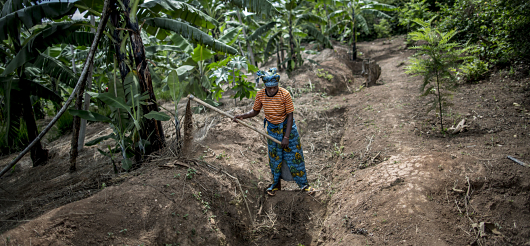Greenhouse gas emissions along a peat swamp forest degradation gradient in the Peruvian Amazon: soil moisture and palm roots effects
10 December 2019
10 December 2019
Tropical peatlands in the Peruvian Amazon exhibit high densities of Mauritia flexuosa palms, which are often cut instead of being climbed for collecting their fruits. This is an important type of forest degradation in the region that could lead to changes in the structure and composition of the forest, quality...
Forest landscape restoration technical planning in Rwanda
10 December 2019
10 December 2019
In 2011, the Government of Rwanda pledged to bring 2 million hectares of deforested and degraded land into restoration by 2020. Compared to Rwanda’s total geographic area, This goal represents the highest proportion committed to the Bonn Challenge to date. Rwanda lost over 65% of its forests between 1956 and...
This case study presents a forest rehabilitation initiative in the tropical dry forests in north- western India. This project is undertaken by an Indian Non Government Organisation (NGO), the Foundation for Ecological Security (FES), in cooperation with the Forest Department and aims at improving the livelihood of tribal communities. The...
Case studies on measuring and assessing forest degradation - Community measurement of carbon stock change for REDD
25 April 2016
25 April 2016
This working paper suggests that degradation is a form of (unsustainable) forest management and that measures to counter degradation, in particular Community Forest Management (CFM) lead not only to reduction in degradation but to forest enhancement as well. While reduced degradation is to be credited and rewarded under a Reduced...
Case studies on measuring and assessing forest degradation - Monitoring degradation in the scope of REDD
25 April 2016
25 April 2016
Deforestation and forest degradation are major sources of greenhouse gas emissions (GHG). Reducing emissions from deforestation and forest degradation (REDD) as a likely component of a global post-Kyoto regime, i.e. after 2012, implies operational and cost efficient monitoring methodologies for providing reliable estimates of the respective forest biomass and carbon...
Sound forest management practices have been seen as an interesting strategy to ally forest conservation and rural economic development in Amazônia. However, the implementation of Reduced Impact Logging (RIL) techniques in the field has been incipient, while most of the Amazonian timber production is generated through predatory and illegal logging....
The present paper is a review of the methods used for assessing defaunation, as a forest degradation component, linked to logging and logging concessions with an emphasis on mammals and Central Africa Rainforests. A discussion on the usefulness and weaknesses of these methods is provided.
Key underlying causes identified in the 2010 report ‘Getting to the Roots: Underlying causes of deforestation and forest degradation, and drivers of forest restoration,’ included: persistently high demand for wood; spiralling demand for land for plantations and other forms of agriculture; conflict over land tenure; industrialisation, urbanisation and infrastructure; poor...
Landscape transformation in tropical Latin America - Assessing trends and policy implications for REDD+
25 April 2016
25 April 2016
Important transformations are underway in tropical landscapes in Latin America with implications for economic development and climate change. Landscape transformation is driven not only by national policies and markets, but also by global market dynamics associated with an increased role for transnational traders and investors. National and global trends affect...
This chapter sets out the site-level strategies and their associated silvicultural techniques for restoring degraded primary forest, managing secondary forest and rehabilitating degraded forest land within the context of an forest landscape restoration (FLR) program. It is intended to provide an overview of the different strategies and methods, along with...

